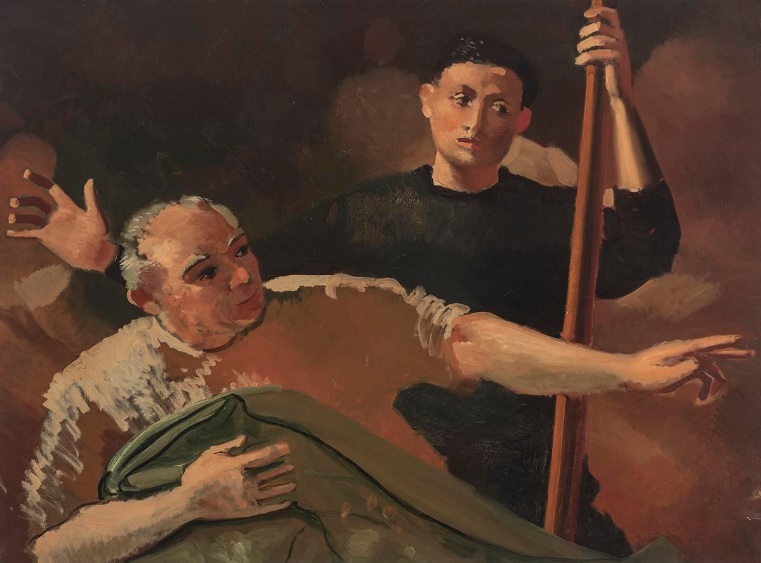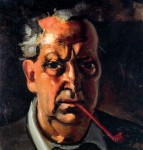
André Derain
French, 1880-1954
The Two Men, 1935
oil on canvas
38 1/4 x 51 1/4 in.
SBMA, Bequest of Wright S. Ludington
1993.1.3

Derain self-portrait from 1953, a year before his death, painted in the subdued color palette that he preferred in his later years.
RESEARCH PAPER
Derain had a strong interest in the works of the late sixteenth and early seventeenth century Renaissance and in the Baroque masters. Caravaggio's device, "tenebrism", the stark contrast of light and dark can be seen in "The Two Men". Very defined images emerge distinctly from the dark background. The figures are so well drawn that they can be read over a great distance. "The Two Men" has many of the same characteristics as "La Chase au Cerf", also executed in 1935, which is at the Musee d'Art Moderne de la Ville de Troyes.
After World War II Derain led a quieter life. Because of a forced trip to Germany during the war he was accused of collaboration with the enemy, which was patently untrue. He was incensed over the French government's treatment of the incident and so would not give or sell his work to the nation. It remained for Alice Derain to do so after his death.
The Two men was completed just prior to the War and illustrates very well his idea of "the subject". We see large simple shapes with serious facial expressions. The gesture of the hand provides meaning, something we cannot see is happening. The many diagonals give a sense of urgency. The palette is of earthly tones, terracotta, olive green with dabs of red for accent and white for highlight.
By the thirties Derain was a well respected painter. During this same time Picasso was in his "Classical Period" and Matisse was making Odalisques. Although Americans were not terribly familiar with Derain, as he was shown mainly in commercial galleries, he did have an influence on Arthur Davies and Walt Kuhn and was included in the infamous Armory Show. Very interestingly during his lifetime he never was accorded the endorsement of a major museum retrospective. This finally occurred the same year of his death, three months later in December.The show was organized by Iean Cassou and was in Paris.
The significance of this work is much the same as that of a poet which Derain also was; it tells a story, has meaning and employes techniques that became associated with Derain. Color and structure combine beautifully to attract us to the body of his work..
"The Two Men" was painted in oil on commercially primed linen.The paint is a rich vehicular paste applied thinly in some areas with rich vehicular brush strokes in the highlights. There is an overall layer of a resinous surface coating. On August 27, 1992, an on-site examination of this piece was performed by a conservator, Denise Domerque. It appears that all the recommendations in her report have been completed. The artist's signature does not appear on the front of the painting but according to the A. Derain Catalogue from the Galerie Schmidt, 1976, it is on the back side.
I was not able to trace prior owners but it is believed to have been completed in 1935. Derain's trusted friend and dealer Paul Guillaume died in 1934 and there is no mention of other dealers following his death until well after the end of World War II. When war was declared Derain moved much of his work to his wife's cousin's home at Castillon en Cousserau in the Pyrenees. All those works survived the war. Those remaining in his home at Chambourcy were badly damaged by Germans who occupied his property, e.g., "Retour d'Ulysse", also painted in 1935. In the late forties and early fifties Alice Derain, his wife, became his intermediary with dealers and collectors. Derain sold many works to private collectors. "TheTwo Men" was shown in the Paris Exposition, 1954-1955, at the Musee National d'Art Moderne. There was a one man exhibit of his work at the Galerie Schmidt in Paris in May/June of 1976. Wright Ludington purchased Two Men from that same Gallery on October 25, 1976 for the equivalent of sixty thousand dollars. It remained in his possession until his death when it was bequeathed to the Santa Barbara Museum of Art.
Derain was born in France Iune 17, 1880 and died September 8, 1954 at Garches Seine-et-Oise, a hospital, following an accident. When Derain first started his artistic career Impressionism was no longer a new phenomenon. Along with Matisse he pioneered the fauvist movement, experimented with Cubism, and in 1910 he worked in Spain with Picasso. Like Picasso he developed an interest in primitive African art and created sculptures for his own pleasure. Unlike Picasso, Derain served in World War I and the experience seemed to leave him abandoning the "avant garde" and returning to figurative painting. As a youth he had spent hours in the Louvre copying the masters and it was the traditions of the past, e.g.,, Renoir, Corot and Courbet that excited him. By the early twenties the "Wild Beast" had turned conservative as had a war weary population. People wanted works they could understand. He did many landscapes and nudes in the period.
Prepared for the Santa Barbara Museum of Art Docent Council by Joan Noble, n.d.
Bibliography
A. Derain - Catalogue - Galerie Schmidt 1976
Derain - Jane Lee, Phaidon Press Limited 1990
Andre Derain Exhibit - Calendar Section, Los Angeles Times by William Wilson, February 27, 1983
Derain - Societe Francaise de Promotion Artistique, 1994
Art Through the Ages - Gardner, Ninth Edition, Harcourt Bruce Jovarovich College Publishers
